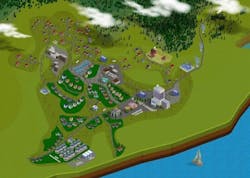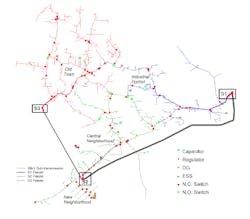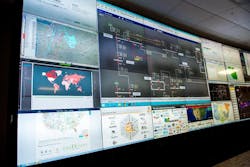Simulating the Distribution System of the Future
The 9500 Node Model
The 9500 Node Model was developed by an industry and academic consortium led by Pacific Northwest National Laboratory in response to the need for a new generation of models. It models the characteristics, behavior, and operational practices of the rapidly evolving utility distribution system. The model is freely available for industry and academia to use and is the first realistic, “right-sized” synthetic power system model developed specifically for benchmarking and sharing of ADMS algorithms in a realistic, real-time simulation environment. This model is currently in the process of being validated for submission to IEEE as a new test system.
The 9500 Node Model adapted the IEEE 8500 Node Model to support realistic, operationally focused simulations and future operational configurations. The new model includes a sub-transmission system, multiple substations, extensive penetration of customer rooftop photovoltaics, and numerous utility-scale distributed energy resources. It is also designed to support procedure-based operations, with the ability to demonstrate switching operations, feeder reconfiguration, adjustment of volt-var control equipment, dispatch of distributed generation, and response to planned and unplanned outages.
The 9500 Node Model includes three radial 12.47kV distribution feeders each supplied by a different 69kV distribution substation. The three distribution feeders are connected to each other through normally-open switches, which is representative of the way many utilities operate in North America. One feeder represents today’s grid with low penetration of customer-side renewables. The second represents a potential future grid with microgrids and 100 percent renewable penetration. The third feeder has no customer resources, a district steam plant, and a utility-scale PV farm. All three feeders have customers connected by low-voltage secondary triplex lines through 120V/240V split-phase transformers.
Bridging the Gap between Academic Research and Industry Needs
A recurring discussion theme is finding ways to bridge the gap between academic research and industry needs. The joint laboratory-university-industry team behind the 9500 Node Model believes the new model will provide a crucial building block for that bridge.
Academic research has historically used open-source test feeders (such as the IEEE 123 Node Model) that are too old and too small to reflect the evolution of the distribution grid. At the same time, most Advanced Distribution Management System (ADMS) vendors use their own proprietary test feeders that are unavailable to the larger power systems community for application benchmarking and information sharing. Although there are plenty of published test cases developed for testing power flow convergence or novel challenges of new topologies, none of them are designed to represent typical day-to-day utility operations.
The 9500 Node Model provides the equipment and framework for new applications to work in tandem with common distribution operator tasks, such as shift turnover, responding to outages, energizing new equipment, preparing switching orders, and facilitating hot-line work requests. It also represents the anticipated smart grid of the future, incorporating “neighborhoods” that have high penetration of renewables, meshed topology, numerous DERs, islanded microgrids, and significantly increased data and measurement density. Some neighborhoods in the test system represent new construction with universal rooftop PV, and others are supported by PV Farms and other DERs. The model developed is needed to both support existing and newer algorithms and to enable evaluation of applications in a realistic operational environment, which is rich in procedural steps that define the interaction between the control center operator and field personnel.
The 9500 Node Model is situated in a “goldilocks” spot in terms of model size, complexity, and realism. It is small enough that it is possible to debug new applications, but large enough to provide realistic operational scenarios (such as equipment faults and maintenance outages) and offer a first test of computational scalability.
Facilitating Discussion among Key Stakeholders
Envisioning the future of distribution operations tools will require collaboration of utility leadership, power engineers, software developers, control room operators, data scientists, and cybersecurity experts. Providing a flexible, open-source model to larger research, industry, and utility communities will also help enable productive discussion among key technical stakeholders.
However, large scale simulation events (such as those used for operator training and cyber drills) have the potential to create an environment for fostering foundational discussions for the future of distribution grid planning and operations. The 9500 Node Model meets key requirements for creating such a simulation environment across multiple platforms through interoperability offered by the Common Information Model.
The Common Information Model (CIM) is a key enabling technology for exchanging distribution network models for advanced analysis and simulation. Although geographic information system (GIS) data formats are the standard for representing utility data, nearly all vendor systems support import and export of models using the Common Information Model. For this reason, the 9500 Node Test System will be released using CIM XML to enable widespread adoption for application development, testing, and benchmarking.
Future Perspectives
It is anticipated that the 9500 Node Model will provide a basis for utilities, vendors, universities, and research laboratories to collaborate, share ideas, and exchange information. Research laboratories will be able to use the new model for testbeds and hardware-in-the-loop simulation of distribution systems with high renewable penetration. Universities will now have a realistic, open-source test feeder for algorithm development and graduate research. Vendors will be able to compare performance benchmarks without interoperability issues of proprietary models and data formats. Utilities will be able to engage with the larger community without the security constraints of real network data and critical energy infrastructure information.
The 9500 Node Model is currently being validated independently for inclusion as an IEEE Test Case and will be released as an open-source data set, along with a series of technical reports and papers detailing the characteristics and sample operational scenarios developed for the model.
The 9500 Node Model was developed by a joint industry-academia team to support the development and testing of advanced distribution system functionality using GridAPPS-D, an open-source platform. GridAPPS-D is being developed by a Pacific Northwest National Laboratory led team as a part of the U.S. Department of Energy’s Advanced Grid Research Program.
Jonathan Barr is a senior research engineer with Pacific Northwest National Laboratory’s Global Security Technology and Policy Group. As a member of PNNL’s GridAPPS-D development team, Mr. Barr applies his expertise in systems engineering and integration, disruptive technologies, and innovation research and development to engage users and plan app development.
Alexander Anderson is a power systems research engineer in the Distributed Systems Group at PNNL. Dr. Anderson’s research focuses on power systems operations, advanced power applications, next-generation energy management systems, defense against cyber-physical threats, microgrid optimization, and human factors in control center environments.
About the Author
Jonathan Barr
Jonathan Barr is a senior research engineer with Pacific Northwest National Laboratory’s Global Security Technology and Policy Group. As a member of PNNL’s GridAPPS-D development team, Mr. Barr applies his expertise in systems engineering and integration, disruptive technologies, and innovation research and development to engage users and plan app development.





